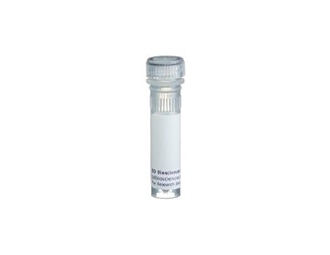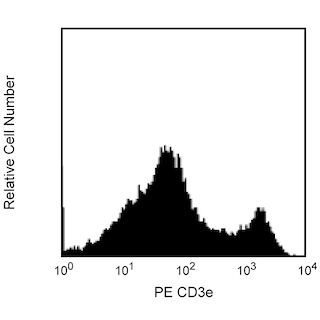Old Browser
Looks like you're visiting us from {countryName}.
Would you like to stay on the current country site or be switched to your country?




Two color analysis of CD38 expression on mouse spleen cells. Single-cell suspensions of BALB/c splenocytes were simultaneously stained with PE Hamster Anti-Mouse CD3e (Cat. No. 553063) and Biotin Rat Anti-Mouse CD38 (Cat. No. 553762; right panel), followed by Avidin-FITC (Cat. No. 554057). Contour plots were derived from gated events with the side and forward light-scatter characteristics of viable splenocytes. Flow cytometry was performed on a BD FACScan™ flow cytometry system.


BD Pharmingen™ Biotin Rat Anti-Mouse CD38

Regulatory Status Legend
Any use of products other than the permitted use without the express written authorization of Becton, Dickinson and Company is strictly prohibited.
Preparation And Storage
Product Notices
- Since applications vary, each investigator should titrate the reagent to obtain optimal results.
- An isotype control should be used at the same concentration as the antibody of interest.
- Caution: Sodium azide yields highly toxic hydrazoic acid under acidic conditions. Dilute azide compounds in running water before discarding to avoid accumulation of potentially explosive deposits in plumbing.
- For fluorochrome spectra and suitable instrument settings, please refer to our Multicolor Flow Cytometry web page at www.bdbiosciences.com/colors.
- Please refer to www.bdbiosciences.com/us/s/resources for technical protocols.
Companion Products




.png?imwidth=320)
The 90 monoclonal antibody specifically binds to CD38, a 42 kDa transmembrane glycoprotein on immature and mature, resting and activated, B lymphocytes. In contrast to humans, CD38 expression is down-regulated on mouse germinal center B cells and plasma cells. CD38 is also expressed on a subpopulation of thymic and peripheral T cells, NK cells, and splenic macrophages. Furthermore, CD38 has been detected on bone marrow-derived hematopoietic stem cells. The CD38 molecule is reported to exhibit both cyclase and hydrolase activities and plays a role in lymphocyte activation. CD31, both human and mouse, is reported to be a ligand for human CD38.
Development References (9)
-
Bean AG, Godfrey DI, Ferlin WG, et al. CD38 expression on mouse T cells: CD38 defines functionally distinct subsets of alpha beta TCR+CD4-CD8- thymocytes. Int Immunol. 1995; 7(2):213-221. (Biology). View Reference
-
Cockayne DA, Muchamuel T, Grimaldi JC, et al. Mice deficient for the ecto-nicotinamide adenine dinucleotide glycohydrolase CD38 exhibit altered humoral immune responses. Blood. 1998; 92(4):1324-1333. (Biology). View Reference
-
Deaglio S, Morra M, Mallone R, et al. Human CD38 (ADP-ribosyl cyclase) is a counter-receptor of CD31, an Ig superfamily member. J Immunol. 1998; 160(1):395-402. (Biology). View Reference
-
Horenstein AL, Stockinger H, Imhof BA, Malavasi F. CD38 binding to human myeloid cells is mediated by mouse and human CD31. Biochem J. 1998; 330(3):1129-1135. (Biology). View Reference
-
Howard M, Grimaldi JC, Bazan JF, et al. Formation and hydrolysis of cyclic ADP-ribose catalyzed by lymphocyte antigen CD38. Science. 1993; 262(5136):1056-1059. (Biology). View Reference
-
Lund F, Solvason N, Grimaldi JC, Parkhouse RM, Howard M. Murine CD38: an immunoregulatory ectoenzyme. Immunol Today. 1995; 16(10):469-473. (Biology). View Reference
-
Oliver AM, Martin F, Kearney JF. Mouse CD38 is down-regulated on germinal center B cells and mature plasma cells. J Immunol. 1997; 158(3):1108-1115. (Immunogen). View Reference
-
Oliver AM. Personal Communication. .
-
Randall TD, Lund FE, Howard MC, Weissman IL. Expression of murine CD38 defines a population of long-term reconstituting hematopoietic stem cells. Blood. 1996; 87(10):4057-4067. (Biology). View Reference
Please refer to Support Documents for Quality Certificates
Global - Refer to manufacturer's instructions for use and related User Manuals and Technical data sheets before using this products as described
Comparisons, where applicable, are made against older BD Technology, manual methods or are general performance claims. Comparisons are not made against non-BD technologies, unless otherwise noted.
For Research Use Only. Not for use in diagnostic or therapeutic procedures.
Report a Site Issue
This form is intended to help us improve our website experience. For other support, please visit our Contact Us page.